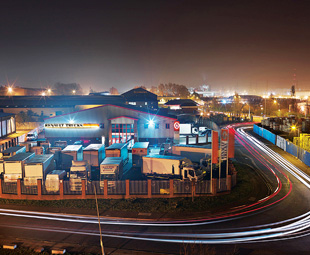Covering your ASSets

It seems the commercial vehicle industry can breathe a slight sigh of relief as its sales figures are on the up-and-up. JACO DE KLERK investigates what this means for this sector’s finance and insurance industries.
Frank Beeton from Econometrix, who writes Global FOCUS – a monthly update of international news relating to the commercial vehicle industry – reported in FOCUS February’s market review that 2012 ended with 27 285 sales for the truck market. This excludes Associated Motor Holdings’ medium commercial vehicle volumes which were reported in aggregated terms during the 2012 calendar year.
These sales figures represent a year-on-year growth of 2,2 percent when compared to the total of 26 300 units, reported in 2011. Last year’s market total was therefore the best result recorded since 2008, and better than any outcome achieved during the 23-year period prior to 2005.
However, as joyous as this is, WesBank Corporate general manager Gerald Burton highlights a possible harsh truth. “Last year’s growth was mostly a wash through from the credit crunch where transporters extended their lead times on fleet replacement,” he points out. “This trend already started in 2010 and matured through 2011, whereby transporters were forced via economic imperatives to re-fleet, rather than to expand.”
Although mere re-fleeting is raining on the commercial vehicle expansion parade, one truth remains; the market is, and always will be, very competitive. Kathy Bell, head of transport solutions at Standard Bank, remarks: “The first port of call for any operator is the ‘supplier of choice’. This supplier will spec the vehicle and trailer combination to be ‘fit for purpose’ so to speak.”
She adds that experienced operators also plan fleet unit replacements around distance and time travelled, factoring in the resale value of the units at the end of the optimum kilometre and fleet cycle. “Maintenance and service contracts offered by suppliers have therefore become key selection criteria,” Bell explains. “Funding and maintenance contracts or agreements are thus matched as realistically as possible to the optimum warranty backed replacement cycle of the fleet.”
But, it is very important for a company to choose the right financial options for its specific operations. “Finance options should match the type of operation, vehicle combination and distance to be travelled,” says Bell. She adds that operators have a range of funding options; such as an instalment credit agreement, a finance lease or usage options – which includes operating – or full-maintenance rentals.
“The preferred funding structure is typically an independent cost analysis with a deposit linked to the replacement cycle of the asset,” Bell points out. “Careful selection of the correct vehicle and trailer combination is often evident with shorter funding cycles, such as 48 or even 38 months, and a kilometre reference linked to the warranty period of the prime mover.”
So this vigilant vehicle selection process combined with a fixed-cost, supplier-backed maintenance package over the finance period of the assets is providing more comfort, appropriate backup and support for operators. “This allows them to focus on providing safe, secure, reliable and competitive transport services that gets products and goods to the market on time and profitably,” says Bell. Hurrah for more profits and punctual delivery of goods!
However, as Burton points out, due to the capital-intensive nature of the industry, transporters are forced to gear their balance sheets up even more than other businesses. “This creates difficulty in securing funding lines through a single financier, leading to transporters becoming ‘multi-banked’, which impacts on the bank’s ability to remain differentiated from its competition,” he explains.
“This ‘multi-banked’ approach also increases risk as many financiers rely on the same security, which waters it down to a large extent when things go wrong,” Burton adds. “These factors impact on the ability of financiers to fund this industry, while also negatively affecting the ability of many transporters to expand past a certain point in terms of fleet size and critical mass.”
He points out, however, that it isn’t all doom and gloom as January proved to be an exceptionally good month, with commercial vehicle sales indicating an upswing in a traditionally quite month – regardless of economic uncertainty. This, along with the fleet replacements, resulted in an increase in new business across all the banks.
But the banks aren’t the only organisations providing financial services, with a number of other companies rising to the aid of commercial vehicle owners. For example, original equipment manufacturers are stepping up to the financial plate with their own offerings.
“Upon entering the industry 15 years ago, there was a gap for customers who required tailor-made solutions to their vehicle financing needs,” says Franz Koller, executive chairman for Mercedes-Benz Financial Services South Africa (MBFS). “This, coupled with the need for a finance house that could offer the same superior customer service as that of our Mercedes-Benz counterpart, gave birth to Mercedes-Benz Financial Services.”
He states that Mercedes-Benz Commercial Vehicles (MBCV) and MBFS have always enjoyed a very close working relationship. “In this way we have managed to deliver one face to our customer base, developing close relationships with them, which ensure that we understand both their vehicle and financial needs.”
Koller adds that the company has experienced more and more success as its brand partner MBCV has grown. “Last year, one in every three commercial vehicles sold by Mercedes-Benz was financed by MBFS, and the figures look optimistic for the years to come.” He says that this supports the old adage of: “who better to finance your vehicle than the people who built it”; with customers recognising the benefits the cooperation between these Mercedes-Benz companies have for them.
It is clear that the symbiotic relationships between the commercial vehicle, finance and insurance industries are ever changing and influencing each other. And, as Burton points out: “The continued fuel price increases and other possible increased input costs, such as labour and toll fees, means that margins will continue to remain under pressure – challenging all operators to remain competitive .”
Published by
Focus on Transport
focusmagsa




